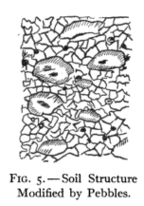Earth:Soil gas
Soil gases are the gases found in the air space between soil components. The spaces between the solid soil particles, if they do not contain water, are filled with air. The primary soil gases are nitrogen, carbon dioxide and oxygen.[1] Oxygen is critical because it allows for respiration of both plant roots and soil organisms. Other natural soil gases include carbon dioxide, nitric oxide, nitrous oxide, methane, and ammonia.[2] Some environmental contaminants below ground produce gas which diffuses through the soil such as from landfill wastes, mining activities, and contamination by petroleum hydrocarbons which produce volatile organic compounds.[3] Soil gases can diffuse into buildings, the chief concerns among these pollutants are radon which is radioactive and causes cancer and methane which can be flammable at only 4.4% concentration.
Gases fill soil pores in the soil structure as water drains or is removed from a soil pore by evaporation or root absorption. The network of pores within the soil aerates, or ventilates, the soil. This aeration network becomes blocked when water enters soil pores. Not only are both soil air and soil water very dynamic parts of soil, but both are often inversely related. To the right, you can see the structure of soil when modified by biotic factors, such as plant roots, and abiotic factors, such as pebbles.
Composition of air in soil and atmosphere:[4]
- Nitrogen: Soil Air: 79.2% Atmosphere: 79.0%
- Oxygen: Soil Air: 20.6% Atmosphere: 20.9%
- Carbon Dioxide: Soil Air: 0.25% Atmosphere: 0.04%
Gas molecules in soil are in continuous thermal motion according to the kinetic theory of gases, there is also collision between molecules - a random walk.
In soil, a concentration gradient causes net movement of molecules from high concentration to low concentration, this gives the movement of gas by diffusion. Numerically, it is explained by Fick's law of diffusion. Soil gas migration, specifically that of hydrocarbon species with one to five carbons, can also be caused by microseepage.[5]
References
- ↑ Pierzynski, Gary M., and J. T. Sims. Soils and Environmental Quality. Boca Raton: Lewis, 1994. 72. Print.
- ↑ Kim, D; Vargas, R; Bond-Lamberty, B; Turetsky, M (2012). "Effects of soil rewetting and thawing on soil gas flaxes: a review of current literature and suggestions for future research". European Geosciences Union: Biogeosciences 9: 2459-2483. https://bg.copernicus.org/articles/9/2459/2012/.
- ↑ Nathanail, Judith, and Paul Bardos. Contaminated Land Management: Ready Reference. Nottingham: Land Quality :, 2002. 44. Print.
- ↑ Russell, E. J.; Appleyard, A. . (1915). "The Atmosphere of the Soil: Its Composition and the Causes of Variation". The Journal of Agricultural Science 7: 1–48. doi:10.1017/S0021859600002410. https://zenodo.org/record/2512689/files/article.pdf.
- ↑ Dembicki, Jr. , Harry (2017-01-01), Dembicki, Jr. , Harry, ed., "Chapter 6 - Surface Geochemistry" (in en), Practical Petroleum Geochemistry for Exploration and Production (Elsevier): pp. 217–252, ISBN 978-0-12-803350-0, https://www.sciencedirect.com/science/article/pii/B9780128033500000064, retrieved 2021-09-30
 |



